A guide to maximizing insights on your iOS acquisition efforts
Apple’s SKAdNetwork isn’t new, but plenty of mystery still surrounds it. With an entirely different data model than traditional mobile measurement partner (MMP) attribution, analyzing performance carries distinct nuances. In this post, we will unpack what you need to know to effectively access and analyze your iOS performance through the SKAdNetwork lens.
In this post:
- Getting SKAdNetwork Data Flowing to Kochava
- Running Campaigns with SKAdNetwork Certified Media Partners
- NEW SKAdNetwork Insights Overview
- SKAdNetwork Explorer within Kochava Cost
- SKAdNetwork Data in Reports & Query
- Key Considerations when Assessing Performance
Getting SKAdNetwork Data Flowing to Kochava
Before you have SKAdNetwork data to analyze in Kochava, you must first complete SKAdNetwork integration. If you’ve already done this, skip to the next section. If not, read on.
Setting up SKAdNetwork support with Kochava involves the following steps:
- Work with your app developer to integrate the latest Kochava iOS software development kit (SDK) and follow the steps in the “Support SKAdNetwork” section of this support doc to ensure the KochavaAdNetwork SDK module is configured during implementation. This module is required to use SKAdNetwork.
- IMPORTANT: You must choose one partner to signal SKAdNetwork for your app. Using more than one partner will result in data discrepancies and campaign optimization issues.
- Once SDK implementation is complete, you will need to configure your SKAdNetwork integration in the dashboard. Follow the steps outlined here to do so. This phase will involve the following:
- Choosing Your SKAdNetwork Conversion Value Model
- With Kochava, available conversion value models include Revenue, Highest Value Event, Engagement, and User Journey. For additional guidance on choosing your model, download our dedicated guide and/or contact your Client Success Manager.
- Choosing Your Conversion Value Model Configuration
- This involves choosing which in-app events and/or revenue ranges to incorporate into your chosen conversion value model paradigm.
- Choosing Your Measurement Window
- This is the length of time after the install that you want to allow repeated conversion value updates to be reported to SKAdNetwork. Kochava offers the most flexible measurement window range, which can be set anywhere between Day of Install out to Day of Install + 7 Days.
- Choosing Your SKAdNetwork Conversion Value Model
Throughout this phase, the decisions you make will impact your ability to effectively analyze SKAdNetwork performance and efficiently optimize campaigns with your media partners. Keep in mind that you’re not stuck with the first conversion value model, event configuration, or measurement window you choose. Across time, you can and should test different configurations with your measurement partner. Be sure to connect with your Client Success Manager or email Support@Kochava.com to understand best practices and implications of changing your model or configuration.
Our team has helped thousands of marketers work through SKAdNetwork configuration, so if you need help or guidance, we’re here for you.
Finding SKAdNetwork Certified Partners
Once SKAdNetwork configuration is complete for your app, you’re ready to launch campaigns that can be measured via SKAdNetwork. Keep in mind that not every media partner is SKAdNetwork-ready. To find media partners that can support your iOS acquisition campaigns over SKAdNetwork, visit our SKAdNetwork Certified Media Partners list here.
Note that each media partner works with SKAdNetwork a bit differently, particularly in what campaign metadata they make available to MMPs to enable more granular performance analysis. Check with your media partner representative for details by partner.
Need to measure cross-promo on SKAdNetwork?If you want to measure cross-promotional campaigns between apps in your own portfolio on Apple’s SKAdNetwork, contact us to find out how our Publisher Tools can help. |
Now let’s review where and how you can analyze SKAdNetwork performance data.
New SKAdNetwork Insights Analytics
SKAdNetwork Insights is a new overview dashboard within the Kochava analytics suite that enables quick access to performance insights on your iOS acquisition efforts measured on SKAdNetwork. The analytics view offers a variety of key performance metrics against several different filters.
| Metrics & KPIs | Filters |
|
|
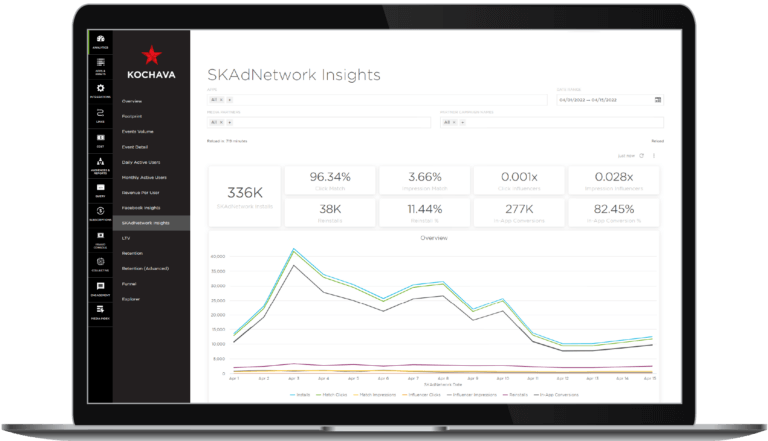
Use this view to understand the overall SKAdNetwork volume for all iOS apps in your account or narrow in on specific iOS apps and particular media partner networks and/or campaigns.
SKAdNetwork Explorer within Kochava Cost
If you utilize Kochava Cost, our new and redesigned cost aggregation solution, you can also explore SKAdNetwork spend and performance data within the SKAdNetwork Explorer view of the Cost module. Filter, split, and pivot data against a host of primary fields, including App, Network, Campaign, etc.
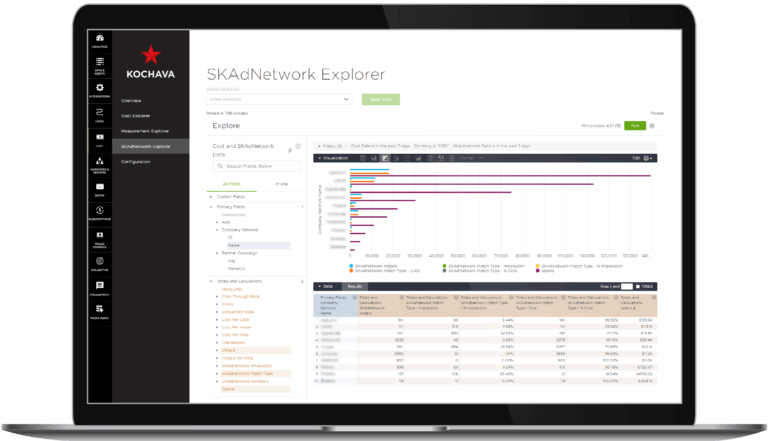
For in-depth documentation on utilizing the SKAdNetwork Explorer, visit our support documentation.
If you’re not currently using Kochava Cost, contact your Client Success Manager to find out how you can activate the feature on your account.
SKAdNetwork Data in Reports & Query
The most granular reporting detail for your SKAdNetwork campaigns can be found in the Kochava reports dashboard, as well as Kochava Query, our built-in structured query language (SQL) prompt utility.
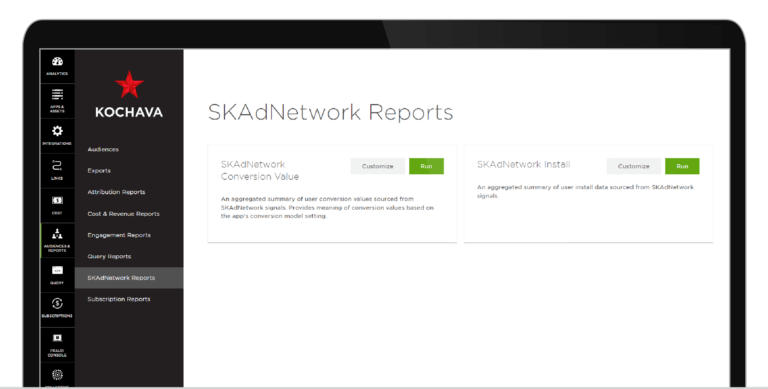
Within the Reports dashboard, there are two different reports available in the “SKAdNetwork Reports” category.
SKAdNetwork Install
- This report provides an aggregated summary of user install and reinstall (redownload) data sourced from SKAdNetwork signals.
- The report can be run at the app level and customized based on a variety of filters, including network, campaign, and other campaign metadata supported by your different media partners.
- To include influencer data in this report, add “influencers” within the TRAFFIC OPTIONS field under the “Traffic Includes” section when customizing a report.
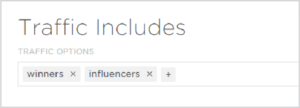
- See a complete list of reporting fields & parameters here.
SKAdNetwork Conversion Value
- This report provides an aggregated summary of user conversion values sourced from SKAdNetwork signals. It also provides the human-readable meaning of conversion values based on the app’s conversion model settings.
- This report can be run at the app level and customized based on a variety of filters, including network, campaign, and other campaign metadata supported by your different media partners.
- See a complete list of reporting fields & parameters here.
Depending on the conversion value model you choose, your SKAdNetwork Conversion Value report will manifest differently. Helpful examples of conversion value reports by each model are available in our SKAdNetwork Conversion Model Guide.
The below excerpt showcases what your conversion value reporting would look like if you chose the ‘Engagement’ model. In the Engagement model, advertisers can select their most important user engagement event. They can then view performance based on: cohorts of users, the count of times those users completed the engagement event, and the days since install it took those users to complete those event counts (up to the chosen measurement window).
As an example, let’s take a casual gaming app that selects their Level Up event and a measurement window of 3 days.

The highlighted row in the example report below, shows a cohort of 16 installs and 2 redownloads engaged with the app up to day 3 after install. The installs and redownloads completed the “Level Up” event nine (9) times prior to disengaging for at least 24 hours from any app activity triggering subsequent conversion value updates.

Seeing blank conversion value entries in your reports?
| Per Apple’s developer documentation, the conversion value only appears in a SKAdNetwork postback if the install app provides it, AND if providing the parameter meets Apple’s privacy threshold. As such, when you see blank entries in your conversion value report, it’s due to the corresponding postback having a ‘null’ value for the conversion-value parameter as a result of Apple’s privacy threshold. The specific details of this privacy threshold have not been provided by Apple to date. |
Kochava Query
SKAdNetwork data is also available in Query to provide marketers with the most flexibility possible when analyzing SKAdNetwork performance.
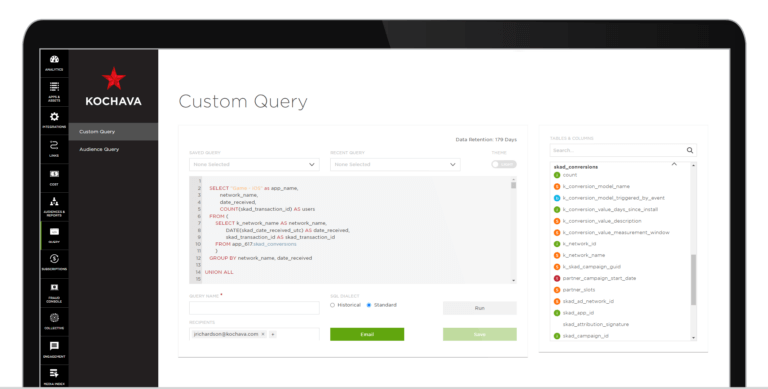
Kochava clients with access to Query can reference the data table entitled “skan_conversions”. Details on all parameter fields available in this report can be found in this support documentation.
If you’re not familiar with SQL and would like assistance in building a custom query against your SKAdNetwork performance data, please contact your Client Success Manager or email Support@Kochava.com.
Key Considerations When Assessing SKAdNetwork Performance
As you look at and work with your SKAdNetwork data in Kochava, here are several key considerations:
Be Patient
SKAdNetwork data is delayed and the longer your measurement window, the more time it takes for all possible conversion data on any particular campaign to make it to your media partners and Kochava. It’s important to understand the soonest and latest you may get the install-validation postback data. The grid below illustrates the relationship between your selected measurement window with Kochava and the time range you can expect the postback data for reporting.
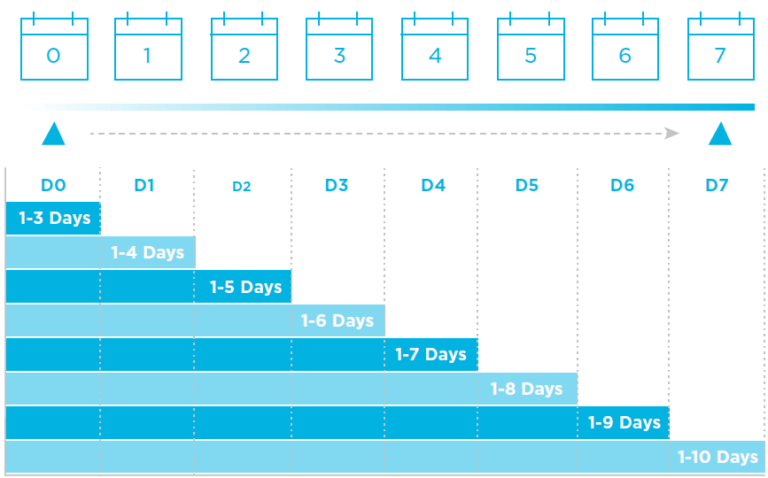
Remember that even if you set a measurement window of day of install + 7 days, not all users will engage with the app and trigger conversion value updates that continually reset Timer 1. As such, expect a distribution of user buckets across the span of your measurement window.
Bottom line, when you’re looking to understand the holistic performance of a campaign, make sure you allow the performance data to fully bake.
Test & Learn
From interviews with numerous user acquisition managers, they’ve found it best to test and learn with each different media partner. Since each ad network partner approaches SKAdNetwork differently, there’s no one-size-fits-all approach to optimizing your efforts. Start with smaller spend and scale as you see success, don’t just throw a bunch of ad dollars at a network and hope it will stick.
For example, some media partners, including Facebook, only optimize on a “Day of Install” measurement window. If you initially chose a conversion measurement window beyond D1, you may want to think about re-configuring your model before you plan to spend big on SKAdNetwork campaigns with such partners. Conversely, if you start spending with another set of partners that support longer conversion measurement windows, testing to see if performance improves by expanding the window is worthwhile – just make sure to scale down or pause spend with other partners who may be negatively impacted by such a change.
Communicate & Educate Your Managers
Your managers may not know about the intricacies of SKAdNetwork or be knowledgeable about the nuances of unique ad network & publisher integrations. However, you can be sure that confusion can ensue when their data models suddenly break, or they’re unable to get the same data segmentation and reporting as they may have been used to on other channels and platforms.
Proactive communication and education with your superiors will go a long way in establishing expectations for how quickly SKAdNetwork can be optimized and the patience required to see if a strategy is truly working. All sides will benefit from an open dialogue.
Remember the Bigger Picture
Remember that SKAdNetwork only covers app-to-app acquisition campaigns. Apple Search Ads, your owned media efforts for web-to-app, consented attribution on paid media efforts across app and web, and unattributed iOS installs will manifest in your MMP attribution reporting outside the confines of SKAdNetwork. Since SKAdNetwork offers no device or user-level identifiers to resolve against, it’s likely that certain users attributed via SKAdNetwork are also represented in one of these other attribution buckets. Analyzing your overall iOS performance with this context in mind is important.
We’re Here to Help
When it comes to SKAdNetwork, there are no dumb questions. As an industry, we all continue to learn and adapt to it. Consider our team here at Kochava as a resource at your disposal to navigate these challenging times in mobile advertising.
Whether you want help selecting the best conversion value model for your app, or you need a hand navigating through a sophisticated SKAdNetwork integration setup with Google or another self-attributing network, or you’re just having trouble deciphering a SKAdNetwork report, contact your Client Success Manager or email Support@Kochava.com.



